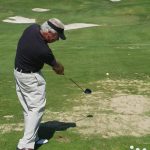What’s the best way to get a golfer to hit down on the ball instead of trying to ‘scoop’ it?
Image credit: GolfWRX
What's in Front of Your Golf Ball?
All too often higher handicap golfers are overly consumed with actually making contact with the golf ball. This interferes with your natural ability to strike the ball with speed at the correct attack angle. Unlike other sports where you are “reacting” to the moving object, golf forces you to “act’ on a stationary object.
What if you placed your conscious effort upon hitting something in front of the golf balls? You’ll be forced to strike “through” the ball to get there. This in turn forces the club to be working its way down to the ball.
Try out the “Hit the Tee” Drill. It forces this situation upon you every time. You’ll be surprised how quickly you’ll learn to strike down on the golf ball with little to no conscious effort.
Miss the towel
I am not the originator of this exercise, but I have found that placing a towel a few inches behind the ball helps the student move their pressure more efficiently and as a result creates a more descending action into the ball.
Really want to improve your golf game? Get incredible swing tips delivered to your inbox every week.
Hit Down Easier
I believe that the easiest way to hit down through the ball is to really understand weight shift. In order for you to hit down through the ball, the grip of the club has to be in front of the ball at the time of impact. This position is way to hard to get into when your body is behind the ball. Too many of my students come in and have a HUGE shift to their trail side. This slide or “sway” makes it almost impossible to shaft back in front of the ball so you can hit down.
Students do this for 2 reasons in my opinion. First, someone told them that they had to shift to the trail leg to hit it further. Or second, they are trying to keep their lower body to stable or quiet. If you understand how to turn properly, you can stay more centered over the ball or even a little left. This will make it so much easier to hit down through the ball into the ground in front of it.
According to GOLFTECs swingTRU motion study where we measured 163 tour players and 35,000 regular golfers, we found a direct correlation between hip sway and handicap. The average Tour player moves their tailbone 3.9 inches TOWARDS the target in the BACKSWING. This is a necessary movement to stay centered or left. The other key number is that the average tour player leans their trail leg TOWARDS the target 11 degrees at the top of the backswing. This is another key position to keep the weight centered to left so you an hit down through the ball.
HERE’S THE DRILL
Setup in a door jam at your house without a club. Place your left heel against the left jam. Make a practice backswing. Your hands should swing into the room behind you and your back pockets should BRUSH AGAINST THE LEFT JAM as you turn. See the picture attached of Arnold Palmer at the top of his backswing His rear end hasn’t left the target side line and his hips and legs are doing exactly what I stated above. This move will make it so much easier to swing on plane and hit down through the ball from the inside.
Focus on your finish
A lot of players think or try too hard to make the club come into the ball on a downward angle of attack. One of the main faults that I see a lot from my students who flip is an improper finish position. Players who tend to “scoop” the ball at impact tend to hang back on their trail leg through impact and often times stay there, even post impact. To help get the club moving on a downward angle of attack, allowing our weight to transfer onto our lead leg will help the club move on a correct path both down and through the shot.
I have attached a photo that shows a comparison of the two finish positions. It is a simple adjustment that has a very positive impact on the overall consistency of impact.

Glen Oak Golf Course, East Amherst, NY
Back, Up, In and Down, Out, Forward
A couple things come to mind on this. Having the student explain their thoughts on impact positions and what they perceive is happening during the impact interval. Are they trying to “help” the ball into the air by flipping their wrists at impact? It is usually a good discussion and leads to my explanation that the club works in a 3 dimensional manner – in the backswing the club travels back, up and inward (inward from the extended target line) and the downswing is down (usually not enough down) out and forward. This can help if properly explained and understood.
Another way is to explain / demonstrate by using an impact bag and discussing the merits of a flat left wrist and bent right wrist (for RH’ers) at impact. I have had great success with both discussions / demonstrations to the student. Since the club is traveling so fast during a normal swing it is always good to feel a static position and capture the feel/look of the correct position. Let Mechanics produce and Feel reproduce as Homer Kelley would say!
Crisp iron shots
Crisp iron shots require a slight descending angle of approach to the golf ball.
Students need to understand that the golf swing is a circle understand where the bottom of the arc of the circle should occur (slightly in front of the golf ball). The question then becomes how to move the bottom of the arc of the circle? Weight shift is the correct answer!
My favorite drill is to paint a line on the ground and have students try to hit the ground or grass in front (side closest to target) of the line.
Low Pointing
This is a good question. It is something I focus on a lot during my lessons, especially for quality iron play.
There are a few things that have to happen so that the low point of your swing is on the target side of the ball.
First we need to understand how the lower body works. There is a slight counter movement into the trail side, more load on trail foot on the backswing. Then there needs to be a weight shift into the lead side on the forward swing. It is very similar to how your body would move to throw a ball. We just don’t step with the lead foot, we shift. At impact we need to be able to have approximately 75% of the weight on the lead foot. If we do not get the weight over there it is virtually impossible to bottom out your club on the target side of the ball.
Additionally we need the handle of the club to lead the clubhead into the ball. I was always taught “the handle wins the race to the ball”. Most people try and make the club head arrive first and they flip or unhinge the club prematurely.
What I have done through the years is to try and explain how the body should move and also how the club should work. When I teach on grass I bury a tee in the ground about an inch past/target side of the ball. I tell them to strike the ball and dig the tee out of the ground. When I teach on turf/mats I will put a piece of duct tape about and inch past/target side of the ball and tell them to strike the ball and peel the tape off of the ground. I will also set up a practice swing piece of tape near the ball and have them try and peel the tape off of the ground with their practice swing.
This is something they can do on there own when they practice, but what I have also found is that this is a very feel based concept. They are not thinking about anything mechanical. They are just swinging their club to a spot past where the ball is. As a whole, this has been a very successful concept for my customers.

Five Ponds Golf Club | Flagler Golf Academy, Warminster, PA
Don't tap it's head...Spank it's bottom!
The student loves to help the ball up…In doing so, they top it or as I like to say: “you are tapping it head”…You need to spank it’s bottom…Position the logo of the ball near the right bottom part of the ground and get the student spank or hit down on the logo part of the ball…Do this about 125 times…They must also hold the impact position no further than 2 feet past the impact…
The perception of scooping the ball for success has been a longtime issue with golfers.
The perception of scooping the ball for success has been a longtime issue with golfers. As a way of eliminating that misperception, I hold a golf ball up and demonstrate the difference with my hands of hitting down or trapping the golf ball vs the scoop. Hitting down creates back spin which lifts the ball and scooping creates top spin which leads to little lift and also little control. The hand demonstration quickly gets the golfer into learning the proper way to impact the golf ball.
At this stage, I take the golf ball and place it on the ground with the range stripe just visible on the ground where I want the student to strike down and most importantly through the golf ball. Having the stripe on the ground is helpful for all because it also helps with focus for the golfer who is a body lifter or chest lifter. I stress keeping the triangle created from the shoulders to the belly button down over the stripe point at impact to mirror their set up and most quickly are into a much better impact position.
At this point, I also try to explain that the divot created actually is ahead of the golf ball due to the hitting down process versus the scooper who most likely hits behind the ball or the middle of the ball. Another method that has helped golfers with the striking position is to think of the ball as a clock and strive to hit the ball at 6 o’clock.

Shift Your Weight Properly
Most ‘scoops’ are the result of an incorrect weight shift on the downswing and follow through. A ‘scoop’ is often coupled with a falling back onto the trail foot as the player tries to lift the golf ball into the air. It can be very difficult to time the release of the scooping motion, which causes poor strikes and a severe loss of power.
To help eliminate the flipping of the hands at impact, it is important to shift your weight to your lead side as you follow through. A good drill is to take some practice swings where your trail foot crosses over the lead foot just after impact, as if you are going to walk after your shot immediately. This will get your weight shifted more properly and help you create energy that moves toward your target instead of away from it. It is also helpful to practice taking divots. Place a tee fairly low in the ground as if you were hitting an iron, and practice clipping the tee as you take a divot on the target side of the tee. Taking a divot does not help if you hit 3 inches behind the golf ball, so practice making divots in the correct place directly post-impact.
These tips should help you hit down through the golf ball with a proper weight shift, which will result in longer, properly struck golf shots.
Evolution of the swing
As a senior player, I was taught to play the ball off my left heel… This was Nicklaus and Watson. My teachers were Dr. Gary Wiren , Bill Strausbaugh and Paul Berthaly. Now there is no lateral shift of the hips . Most players take the club steeper or more upright and place the ball closer to center in the stance.You also see stronger grips , which will close the clubface faster.
A Few Factors
I see a lot of beginners who top the ball and catch it thin a lot. I always tell them that this is a lot of times not such a swing issue, but rather a simple matter of just hitting the ground solid more consistently through impact by returning the club head to where it started (grounded behind the ball). Oftentimes the reason people have trouble with this is related to posture (standing too erect or not maintaining the correct posture through impact), their grip pressure being too tight, or sometimes it’s also related to their angle of attack not being steep enough in their downswing.
So, I usually like to teach my students to just bend more from the waist, hang loose with their grip pressure and feel like they’re making a relaxed up & down swing, letting the club drop/free fall onto the ball from the top of their backswing. This will let the club bottom out more naturally through impact, as I really don’t like to tell people too much to swing down at the ball since the golf swing should never feel forced like you’re chopping wood, but rather more smooth, loose and rhythmic.
Gravity! A relationship worth appreciating!
In the backswing the club and arms move back and up in context. If there is any more obvious influence then gravity I don’t know it! The down part of the swing could be the simplest of all the swing movements. Play with the fall or lengthening of the arms as you rotate and extend into your follow through!
Brush and Finish !
I wouldn’t tell any of my average Golfer lessons to hit down. That usually equates to a “Fat” shot. Most golfers need to Feel they are sweeping or brushing the turf six inches before and six inches after the ball. Keep the club accelerating through the hitting area . And don’t forget – finish the swing and pose every time !!!
Don't think hit down on the ball!
Telling students to hit down on the ball isn’t the answer. If they always miss the ground it’s either a concept or fear thing. Their concept is wrong because they think they can lift the ball off the ground. I explain why it’s possible but leads to poor contact, then have them hit balls off of a low tee making sure that they don’t hit another ball until they get the tee out of the ground. I explain that the only way to get it out of the ground is to relax and let the club head be drug through the ball / tee. Tension is brought on by fear and poor understanding of how tight the club should be held.
Descending Angle of Approach--Why and How.
It is possible to play decent golf picking, or scooping the ball rather than hitting down and through it, but doing so leaves zero margin for error. And with the ball setting on the ground, it is impossible to play well with the club coming up, lifting the ball. Hitting down provides the greatest margin of error, because in doing so the club can contact the ball on the first, second, or third groove, and still result in a fairly decent shot.
To accomplish this, make sure that at impact the shaft angle is tilted a bit with the hands closer to the target than the clubhead. Think of the ball and the plane of impact as the finish line of a race, making sure that the hands get through that finish line before the clubhead does. If the hands win, the clubhead is still descending. Then, if you are still trying to “pick” the ball off the turf, remember, as my friend Bobby Steiner teaches, to “surrender the clubhead to gravity”. In other words, let it freefall!
Start hitting it solid, its all about balance!
For players of any skill level, it is so important to define your balance at impact! Generally, every great ball striker has all of their weight firmly on their forward foot at impact!!! Establish confidence in this by setting up for some short swings (waist to shoulder high) with 95% of your weight planted on your front foot and hit some easy pitch shots from a good lie without a target. Get the sensation of an exaggerated impact position, and it will carry forward later when you practice your full swing. Build some confidence in striking the ball first. All of the greats practice some version of this drill every day to maintain confidence in the impact position.
Have a plan, and focus on every swing to get to that position. It is somewhat counter-intuitive to new players, but trust me, this is the foundation of every great golf swing. In 58 years of golf , I have yet to see a good shot struck with any weight on the back foot.(with the exception of an unusually crazy bunker or an extreme hill lie)
As always, enjoy the game and the process of understanding the game and playing better.
Lean the Shaft
First I don’t like the intent of trying to hit down on the ball. Before you know it they’ll be sticking the club in the ground. The reason folks “scoop” the ball is because they are trying to help it in the air. Start my simulating a good impact position using an impact bag if possible. Weight about 85% into the front foot, hips about 20’ open, chest facing the ball, hands/grip in front if the club head, LEANING the shaft forward. Then start hitting wedges about 30 yards trying to get into that same good impact position and above all don’t try to help the ball in air let the loft on the club do the work.
Striking down to hit hit better
Place a towel on the ground, now put a golf ball roughly 5 inches in front of it. As go to hit the golf ball your job is to MISS the towel, if you nick it or it moves NO good. Hope this helps
Don’t scoop!
This is a great topic to cover. I find that most players play the ball too far forward in their stance because the path of their swing is outside in. Once that happens they are doomed to scoop the rest of their life to understand how to hit a golf ball correctly you have to understand club shaft plane and I understand that if the shaft is on the correct plane it will create the lag necessary to have forward Shaft Lean. Forward shaft lean creates the downward angle of attack not a steep downswing.
Clear out!
In order to stay down and cover the ball with a downward blow, we must clear our lead side out of the way. Feel like your body is opening up to the target, only after you get the weight into your lead leg, hip joint.




















